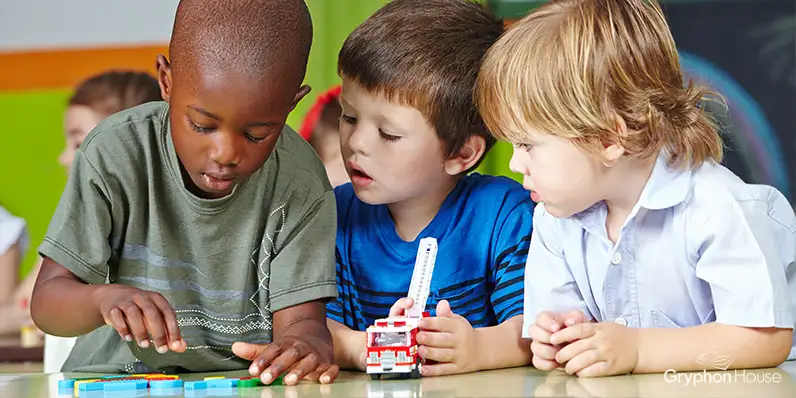STEM is a vital part of children’s education, but what if there are children who don’t seem to find interest in STEM concepts?

STEM is a vital part of children’s education, but what if there are children who don’t seem to find interest in STEM concepts?
The key to helping these children learn and gain interest in STEM is to tap into and harness their natural curiosity. Use these three short activities to peak students’ interest in STEM activities, and keep a child’s interest piqued with STEM Play: Integrating Inquiry into Learning Centers.
Science—We Go Together
Scientists sort objects to find out what things are similar and go together. Children will enjoy organizing different objects at the science center.
Sills supported:
- Observing
- Noticing details
- Categorizing
- Sorting
- Using emergent writing
Materials:
What to do:
- Explain that sorting science objects is something scientists do. They must look closely and observe different objects they find, then they decide how those objects go together. Scientists have created categories for all living things, including animals. They also categorize rocks by how they were formed and what they look like.
- Explain that when they visit the classroom science center, they will get to be scientists and look at the objects closely so they can decide which ones go together. Tell children that if they want to record how they sort the objects, they can write and draw pictures.
Technology—Changes, Changes
Children love to tell stories. The book Changes, Changes tells a story with blocks. In this activity, children are challenged to tell the story from looking at the pictures in the book. They can also think of their own story while building.
Skills supported:
- Demonstrating creative expression
- Listening
- Using narrative language
- Noticing details
- Using technology
Materials:
- Blocks
- Changes, Changes by Pat Hutchins
- Camera, iPad, or tablet computer with a camera and microphone
- Story-creation app such as StoryKit (optional)
What to do:
- Gather the children and introduce the book Changes, Changes. Tell children that the story you are reading today does not have any words, so you need for them to help tell the story. You might say, “In most picture books, we read words and look at pictures. The words and pictures together tell the story. Because this book has only pictures, we will add words to the story.”
- Invite children to look at each picture spread in the book. After looking at the pictures, call on a child to tell the story based on the picture. Continue this way until you have finished reading the book.
- Ask children if they can make a block structure that is similar to something in the book. Ask them to think about what stories they can tell with their blocks.
- Help children take pictures of the structures and record the words of their stories using a story-creation app, such as StoryKit.
Engineering/Math—Building Towers
Children build towers with cubes or blocks to practice counting.
Skills Supported:
- Developing fine motor skills
- Developing number sense
- Developing one-to-one correspondence
- Developing social-emotional skills
Materials:
- Number cards
- Number dice with 0 to 6 written on the sides
- Pictures of towers
- Snap cubes and blocks
What to do:
- Tell children they can play a game at the classroom Math Station. Note that the math materials include a special container that has a number dice, snap cubes or blocks, and pictures of towers.
- To play, a child must roll a die and then pick that number of cubes or blocks.
- The child will also pick a picture of a tower.
- The child will put the cubes or blocks together to build a tower resembling the one in the picture.
- When she is done building, she will find the number card that shows how many cubes or blocks she used.
- Demonstrate for the children how to play the game.

